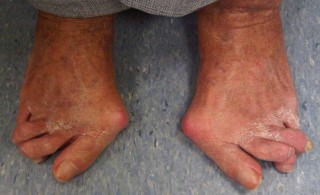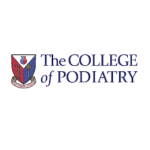 by Anthony Maher. BSc Hons, MSc, FCPodS, Clinical Lead Consultant Podiatric Surgeon, Nottinghamshire Healthcare NHS Foundation Trust.
by Anthony Maher. BSc Hons, MSc, FCPodS, Clinical Lead Consultant Podiatric Surgeon, Nottinghamshire Healthcare NHS Foundation Trust.
A lot of the time we pay little attention to our feet, that is until something goes wrong. Most of us, luckily, will only occasionally experience foot pain sometime in our life, but for some that pain can be significant, causing pain when walking, limiting choice of footwear and even reducing activity or increasing the risk of falls.
The big toe joint or 1st metatarso-phalangeal joint is one of the most common areas of the foot to become painful (Gilheany, Landorf, & Robinson, 2008; Maher & Kilmartin, 2011). Often pain here develops progressively over a number of years but can also occur acutely as a result of an injury. This short article will discuss three of the most common causes of big toe joint pain and how best to treat them.
Bunions
Bunions known as ‘Hallux abducto-valgus’ are the most common cause of big toe joint pain. A bunion is characterised by a prominent bump over the inside border of the foot which presses painfully against the shoe while at the same time the big toe moves towards the second toe.

A bunion isn’t a growth; it is in fact a mal-alignment of the bones which make up the big toe joint. The mal-alignment may begin in childhood or adulthood. Genetics play a part in the development of bunions but they are much more prevalent in shoe wearing populations. In fact 30% of shoe wearing adults will have evidence of a bunion – have a look now! As we age, the incidence increases to 70%, and left untreated over 70% of those bunions will also develop osteoarthritis causing pain and stiffness of the joint itself. Bunions are more common in females, in older age and are also more common in people with hip or knee problems (Gilheany et al., 2008; Roddy, Zhang, & Doherty, 2008). Bunions can be very painful but symptoms vary greatly from patient to patient. In the most severe cases we see large bursa’s forming (fluid filled sacks) over the bunion while the big toe can press so hard against the 2nd toe that it dislocates or buckles giving rise to a hammer toe.
Osteoarthritis (OA)
OA of the big toe joint presents as pain and stiffness and like bunions is a very common cause of foot pain (Maher, 2017). Around 10% of adults will have signs of arthritis within the joint but that increases to 44% with aging (Gilheany et al., 2008). In podiatric practice arthritis of the big toe joint is staged in line with how much movement is restricted, from a hallux limitus with some restriction to hallux rigidus with no movement. Rather than a bump on the side of the joint, hallux rigidus can result in a large bump over the top of the foot and this can cause significant problems with wearing closed in shoes. This bump is a growth of bone related to the joint disease process that restricts the movement of the joint, often leading to patients altering their walking style to enable normal gait. This sort of problem tends to develop very slowly over a number of decades, but certain sports can make people aware of problems earlier on. Occasionally arthritis will develop rapidly in the joint following an injury.
Gout
Gout is an exceedingly painful condition characterised by a red hot swollen joint with a rapid onset of severe pain most commonly in the big toe joint or ankle, but other joints can be affected. It occurs when urate crystals form in the joint when there is an increased concentration of urate in the blood. The pain may first occur in the middle of the night and more commonly effects men over 40 years of age. The pain can be so intense that even bed sheets cannot be tolerated. Attacks of gout may occur every few months and are often related to obesity, alcohol intake and certain foods or medications. Gout is also related to number of other medical conditions and genetics.
Easing big toe joint pain
If you do develop big toe joint pain, the good news is there are quite a few simple measures you can try yourself. First, if your foot hurts and you’re able to rest then do so. The mnemonic ‘RICE’ is always worth remembering; Rest, Ice, Compression and Elevation. If you find that your big toe joint is pressing against shoes causing pain, consider wearing a wider or softer shoe. Traditional leather shoes are not kind to bunions. Some manufacturers will produce shoes and even walking boots with a specific bunion fit. Pain killers can help such as Paracetamol or Ibuprofen but please seek advice from a professional if you are uncertain about taking medicines.
Various pads, splints and cushions are available to buy and while cushions and pads may offer some relief in certain shoes, there is little evidence that splinting helps.
If these basic measures fail to offer adequate relief it is time to ask your GP for a referral to a podiatrist or podiatric surgeon. Podiatrists will assess your feet and confirm the diagnosis. They may offer more tailored footwear and foot health advice and may suggest other treatments for big toe joint pain such as orthotics to improve the function of the joint or steroid injections. Both of these treatments can be particularly helpful in relieving the pain relating to osteoarthritis of the big toe joint but are less helpful in correcting bunions. If gout is suspected, your GP may order further tests and may prescribe lifestyle changes and medication before making a referral.
Finally having exhausted conservative treatment options, you may wish to talk to a podiatric surgeon about your surgical options. Podiatric surgeons are podiatrists who have completed specialist training in surgery of the foot and associated structures. They will organise investigations such as x-rays and can offer expert advice on surgery and help you to weigh up the relative benefits and risks of treatment.
Surgery if required can often be performed as a day case under local anaesthetic with most patients able to return to a pair of supportive trainer type shoes from 2 weeks post operation. Though it can take many months to fully recover, your podiatric surgeon will continue to offer support and rehabilitation with the aim of allowing a return to a comfortable and active lifestyle.
All in all though there are a number of options for treating pain and deformity of the big toe joint and after self-care if symptoms persist podiatric intervention is a valuable resource for a complete resolution. Big toe pain does not have to be a pain in the….!
References
Gilheany, M. F., Landorf, K. B., & Robinson, P. (2008). Hallux valgus and hallux rigidus: a comparison of impact on health-related quality of life in patients presenting to foot surgeons in Australia. Journal of Foot and Ankle Research, 1, 14. https://doi.org/10.1186/1757-1146-1-14
Maher, A. J. (2017). Patient reported outcomes six months following surgical treatment of end stage hallux rigidus in a community based podiatric surgery service. Foot, 30. https://doi.org/10.1016/j.foot.2017.01.007
Maher, A. J., & Kilmartin, T. E. (2011). Patient Reported Outcomes following the combined rotation scarf and Akin’s osteotomies in 71 consecutive cases. Foot, 21(1), 37–44. https://doi.org/10.1016/j.foot.2010.11.002
Roddy, E., Zhang, W., & Doherty, M. (2008). Prevalence and associations of hallux valgus in a primary care population. Arthritis Care and Research, 59(6), 857–862. https://doi.org/10.1002/art.23709

